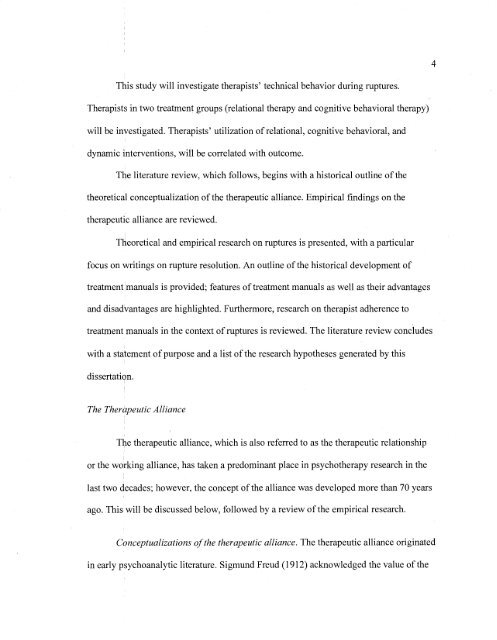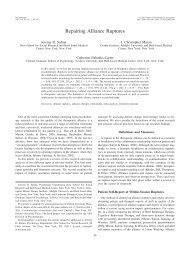Download - The Safran Lab
Download - The Safran Lab
Download - The Safran Lab
Create successful ePaper yourself
Turn your PDF publications into a flip-book with our unique Google optimized e-Paper software.
This study will investigate therapists' technical behavior during ruptures.<br />
<strong>The</strong>rapists in two treatment groups (relational therapy and cognitive behavioral therapy)<br />
will be investigated. <strong>The</strong>rapists' utilization of relational, cognitive behavioral, and<br />
dynamic interventions, will be correlated with outcome.<br />
<strong>The</strong> literature review, which follows, begins with a historical outline of the<br />
theoretical conceptualization of the therapeutic alliance. Empirical findings on the<br />
therapeutic alliance are reviewed.<br />
<strong>The</strong>oretical and empirical research on ruptures is presented, with a particular<br />
focus on writings on rupture resolution. An outline of the historical development of<br />
treatment manuals is provided; features of treatment manuals as well as their advantages<br />
and disadvantages are highlighted. Furthermore, research on therapist adherence to<br />
treatment manuals in the context of ruptures is reviewed. <strong>The</strong> literature review concludes<br />
with a statement of purpose and a list of the research hypotheses generated by this<br />
dissertation.<br />
<strong>The</strong> <strong>The</strong>rapeutic Alliance<br />
<strong>The</strong> therapeutic alliance, which is also referred to as the therapeutic relationship<br />
or the working alliance, has taken a predominant place in psychotherapy research in the<br />
last two decades; however, the concept of the alliance was developed more than 70 years<br />
ago. This will be discussed below, followed by a review of the empirical research.<br />
Conceptualizations of the therapeutic alliance. <strong>The</strong> therapeutic alliance originated<br />
in early psychoanalytic literature. Sigmund Freud (1912) acknowledged the value of the<br />
4



